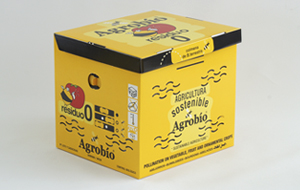Summer hive

THE HIVE
The summer hive for protected crops is taller and better ventilated than the winter hive. In this way bumblebees are able to resist higher temperatures. The hive contains a nest in development, consisting of:
- A fertilized queen
- Adult workers
- Worker pupae
- Larvae
- Eggs
The hive is supplied with enough food to meet their life cycle.
Species: Bombus terrestris. Agrobío produces different bumblebee species and subspecies, please, consult your local authorities which species are allowed.
SUGGESTED CROPS
- Vegetables: tomato, eggplant, sweet pepper, courgette, etc.
BENEFITS OF USING BUMBLEBEES
- Better fruit quality.
- Higher production.
- Time and workforce savings.
HANDLING OF THE SUMMER HIVE
- Place the summer hive on a firm support and protected against ants.
- High temperature conditions:
– Place the hive in well ventilated areas to avoid extreme heat and protect from direct sunlight placing it in the shade.
– It is recommended opening the hive early in the morning or late in the afternoon.
- Low temperature conditions:
– Place the summer hive up high, in sheltered areas of the greenhouse (avoid it to get wet in the rain).
- The entrance of the hive should always be visible to the bumblebee.
- If several hives are placed together is advisable to orient their exits in different directions to avoid confusion of the workers.
- When entering the hive in the greenhouse, you should wait until bumblebees are quiet before opening the lock.
PERFORMANCE
The main factors influencing the performance of the summer hive are:
- Food: nectar and pollen are essential for the proper development of the colony. Agrobío incorporates a substitute food with the most important nutrients so that the hives can achieve an appropiate performance during their life cycle.
- Isolation: Agrobío supplies hives specially designed for each season, isolating them from bad weather conditions and improving ventilation without excessive moisture condensation.
- The weather: the cold usually does not directly affect the hives. In the nature you can find bumblebees visiting flowers at low temperatures. The lack of activity in winter is due to the inability of the plants to keep the flowers in peak condition.


